Evil Dead's History And Legacy: Ash Vs. Evil Dead Is Easily One Of The Best Legacyquels We've Seen
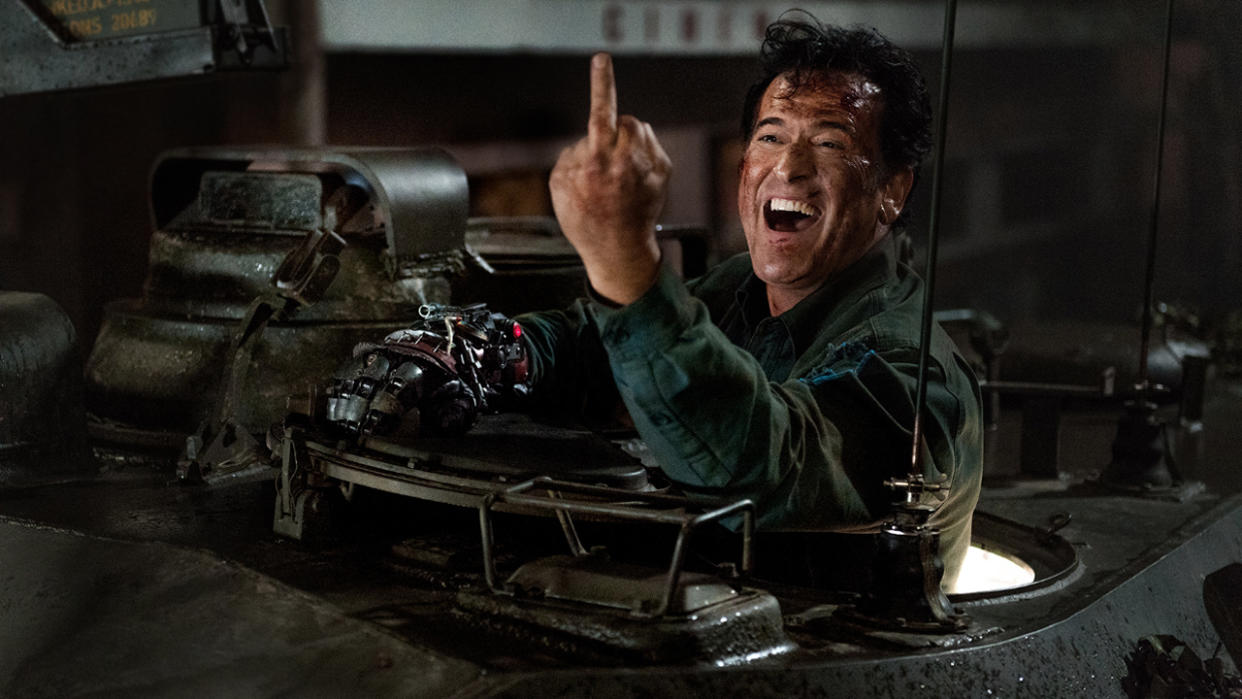
After the theatrical release of Sam Raimi’s Army Of Darkness in 1993, it appeared that Evil Dead did not have a future as a movie franchise. Though both The Evil Dead and Evil Dead II had gained cult followings during the 1980s, the second sequel did not perform well at all on the big screen, and the idea of continuing the adventures of hero Ashley J. Williams was not sellable. As I noted in last week’s column about the 2013 Evil Dead reboot/remake, this thankfully didn’t derail the careers of the filmmakers involved, as Raimi, producer Rob Tapert and star Bruce Campbell all found continued success through the 1990s – both furthering their individual careers and still collaborating (for example, Raimi and Tapert produced the shows Hercules: The Legendary Journeys and Xena: Warrior Princess, which featured Campbell as the recurring character Autolycus.)
But the dream of making an Evil Dead 4/Army Of Darkness 2 never totally left their minds. The horror franchise may have seemed lifeless from an outsider perspective, but Sam Raimi and his brother Ivan (who co-wrote the script for Army Of Darkness) continued to pursue different ideas and work on multiple drafts of a screenplay. As they describe on the commentary track for the first episode of Ash vs. Evil Dead, one idea for a follow-up had Ash as a documentary filmmaker traveling the country trying to tell people his story, and another was a futuristic sci-fi tale called Ash vs. The Machines.
This passion served the Evil Dead creators well, because time was on their side. Army Of Darkness may not have been an instant hit when it played in theaters, but the expanding home video market and the rise of the internet at the end of the 20th century changed its pop culture legacy. As Sam Raimi recounts on the Ash vs. Evil Dead commentary, it was Bruce Campbell who was the first of the core trio to discover extreme growth in the fanbase:
We love the character, and we love the series ourselves, but there wasn’t a lot of fans, and the internet was pretty non-existent at that time. But [Bruce Campbell] found out through the conventions that [he] went through that there was a fanbase out there, and they seemed not to die, but rather, as you remember, to grow. Every year there would be a few hundred more and the word of the movies was spreading through DVD and through television and cable.
Attempting to take advantage of this expanding appreciation was in part what led to the aforementioned Evil Dead reboot – which was, unlike Army Of Darkness, a box office hit, making $97.5 million worldwide from a $17 million budget (per Box Office Mojo). Rather than the success perpetuating the development of a direct sequel, however, a pivot was inspired, both in terms of continuity and medium. Rob Tapert explains in the commentary,
When Sam and I and Bruce, we did the remake of Evil Dead, directed by Fede álvarez, after that came out we met with one of the executives we had worked with, and we were talking about doing a sequel to that. And he said, ‘Well, I actually don’t think you should do a sequel; I think you should do a TV show.’ And at that time I thought he was just nuts, and it didn’t really make sense. But in thinking about it over time, and if Bruce was going to come back, suddenly you go, ‘Well, there is a version of this.’
When Rob Tapert pitched the idea to Sam Raimi during a barbecue around 2013, not only was it an idea that engaged the imaginations of the filmmakers, but television was seen as a kind of natural progression for Evil Dead. While Raimi is best known for his work making features, he acknowledged that Bruce Campbell had cemented an impressive reputation on the small screen that would help the project, the actor not only appearing on shows like Xena and Hercules but also the popular USA spy series Burn Notice.
The original target for Ash vs. Evil Dead was Netflix, as Rob Tapert had read that the Evil Dead movies were extremely popular on the service – but when they passed, Starz became a target. Tapert and Raimi had previous experience with the premium cable network, having produced the series Spartacus, and they were willing to give the project the one thing that the filmmakers demanded above all else. Raimi’s words,
We had to have absolute creative control. That was the deal. And it really wasn’t out of… I don’t want to say it wasn’t out of ego, because it probably was, but what was really underlying that need is the fact that we had these fans for 35 years. We made one movie in a very particular way; we made the second movie as a continuation, even though the tone had changed; and a third movie. And these people had been on this journey, and we couldn’t have some young, even intelligent, executives giving us their vision of what it might be.
Co-starring Ray Santiago, Dana DeLorenzo, and Lucy Lawless opposite Bruce Campbell, the show had its hiccups. Rights issues with Universal Pictures meant that there couldn’t be any references made to the events in Army Of Darkness; showrunner Craig DiGregorio was replaced by Mark Verheiden after Season 2 due to creative clashes with Rob Tapert; and the series wasn’t able to complete its five-season vision, as it was canceled shortly before the airing of the Season 3 finale. All that being said, Ash vs. Evil Dead can be reflected upon as a dream-like gift for fans who never thought the hero’s journey would continue after the end of the film trilogy, and it’s an unmissable part of Evil Dead’s History And Legacy.
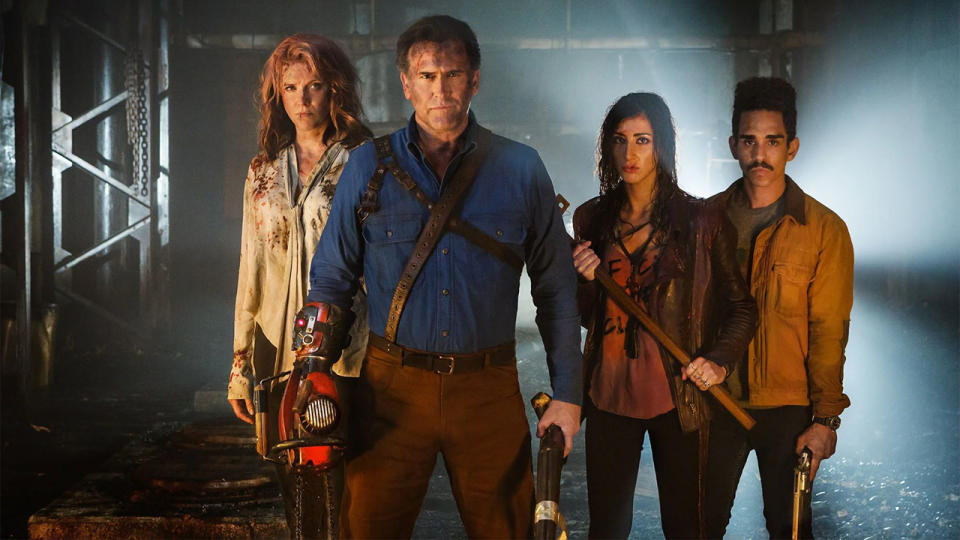
How Ash Vs. Evil Dead Fits Into The Evil Dead Franchise
As horror franchises started moving to television in the 2010s, multiple different tactics were taken in regards to canon and continuity. It was an era of prequels (Bates Motel), re-adaptations (Hannibal), and total reboots (Scream: The TV Series). Ash vs. Evil Dead stands out from the pack because of its maintained connections to the past. The medieval adventures of Ash Williams are never discussed because of the conflict with Universal, but a concentrated effort is made to keep everything connected – and it even finds ways to humorously point at the incongruities that exist between The Evil Dead and Evil Dead II.
What additionally makes Ash’s return so special, though, is the way in which Ash vs. Evil Dead is able to resurrect the best version of the character. As I noted in my column about Army Of Darkness, Sam Raimi has said that he disengages with Ash in the third act of the film because he evolves into a typical hero after being much more interesting as a cad/weenie/dolt. The protagonist on the show has his moments as a champion and delivers an endless stream of badass, confident one-liners, but it never betrays who he really is, and it earns a lot of love for that.
Ash vs. Evil Dead finds terrific ways to both build on the existing lore and add to the beloved aesthetics and style. On the former front, we get to learn a great deal more about the history and capabilities of the Necronomicon (particularly through the introduction of Lucy Lawless’ Ruby), and Season 2 even pulls off some time travel that has the characters go back to the early 1980s and visit the notorious cabin in the woods before young Ash’s fateful arrival. As for the latter, Sam Raimi only directed the show’s pilot, but his auteur trademarks that were established in the early Evil Dead films are still peppered throughout the 30-episode run, and, of course, there are gallons upon gallons of fake blood as the heroes are constantly put in both horrifying and disgusting circumstances in the on-going war against the Deadites.
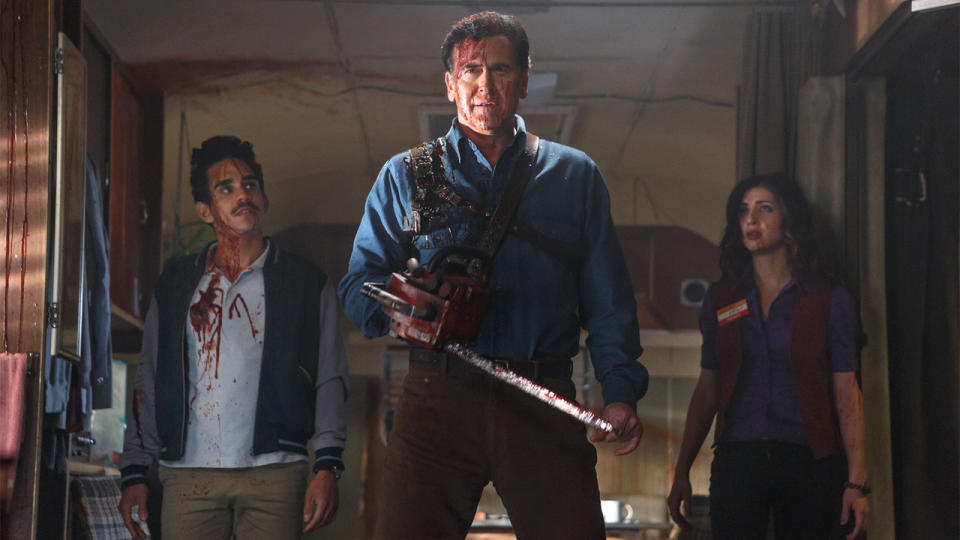
How Ash Vs. Evil Dead Fits Into The History Of Horror
While Rob Tapert doesn’t mention it in the commentary track, one has to imagine that a motivating factor in bringing Evil Dead to the small screen in the mid-‘00s was because it was an ongoing trend at the time for horror franchises. In the burgeoning golden age of television, serial storytelling was recognized as an exciting creative avenue that could provide fans with more content than big screen releases (case in point, the 30 episodes of Ash vs. Evil Dead equals about 15 hours of scary fun, while the combined running time for the theatrical cuts of the original Evil Dead trilogy is a little over four hours).
What makes the show particularly special for its era, however, is the fact that it’s not only a part of the wave of IP-driven horror television, but also the on-going legacyquel trend. The most fashionable thing that franchises can do nowadays is develop new chapters that feature the return of classic characters, and while movies like J.J. Abrams’ Star Wars: The Force Awakens, Ryan Coogler’s Creed, and David Gordon Green’s Halloween are viewed as trendsetters, it should be recognized that Ash vs. Evil Dead technically predates all of them.

How Ash Vs. Evil Dead Changes Its Franchise's Canon And Future
While there are three movies featuring Bruce Campbell’s Ashley J. Williams, none of them make a point of digging into the actual life of the character beyond his nightmarish experiences – but that’s a freedom that Ash vs. Evil Dead has thanks to the expanded runtime real estate. The events of Army Of Darkness are ignored, but through the course of the show we learn about Ash’s horrible life after returning to his hometown of Elk Grove, Michigan following the incident at the cabin – where he is given the nickname “Ashy Slashy” and tormented until he is forced to run away. Lee Majors is terrific as Ash’s father, Brock Williams, and we even learn what the “J” initial stands for: Joanna.
As for how Ash vs. Evil Dead will impact the future of the Evil Dead franchise… that’s a story that has not yet been fully written. While the canon is expanding with the arrival of Evil Dead Rise, the 2023 film doesn’t do anything that overlaps or interferes with anything that developed from the Starz show, so the door is open for continuation. Ray Santiago and Dana DeLorenzo have already reprised their respective roles as Pablo Simon Bolivar and Kelly Maxwell in Evil Dead: The Game, and Bruce Campbell has spoken about the possibility of the show being revived in animation.
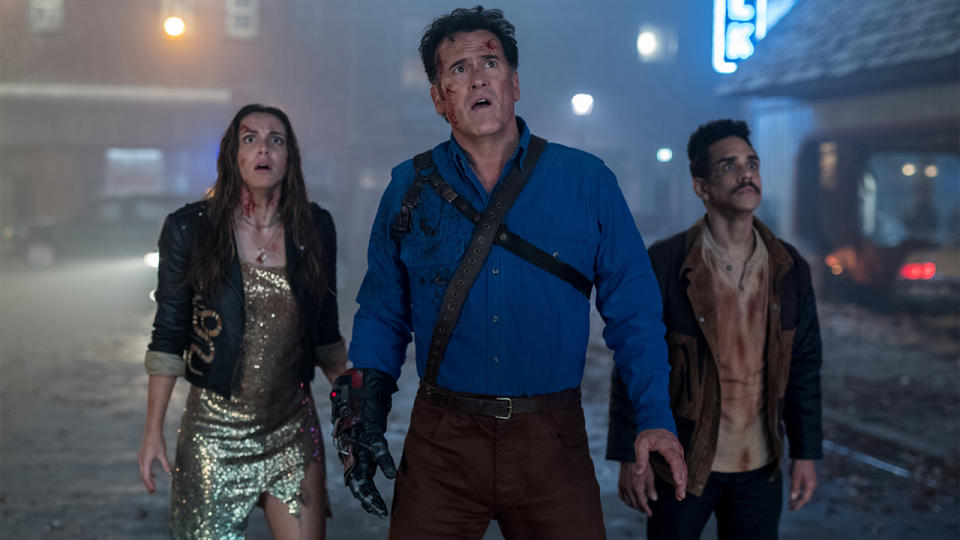
Is Ash Vs. Evil Dead A Good Horror TV Series In General?
I can’t say for certain how Ash vs. Evil Dead would play for an individual who is wholly new to the Evil Dead given the fact that it heavily leans on the established lore – but at the same time, I’d like to think that it’s a show that any horror could fall in love with. Silly as Ash may be, Bruce Campbell is endlessly magnetic in the role and there isn’t even the briefest of moments where the shtick gets old. And while it can be incredibly challenging to introduce exciting new characters into an established franchise, Ray Santiago, Dana DeLorenzo and Lucy Lawless are all phenomenal in dynamic and fun roles that each work as terrific foils to Ash.
The heroes and villains are what make the show great, but the approach to horror is what makes it special. Season 1 is a bit repetitive in its unleashing of Deadites that Ash, Pablo and Kelly have to dispatch in excessively bloody action, but once Ash vs. Evil Dead finds its groove, it gets exceptionally creative… and disgusting (also: watching Ash use his chainsaw and boomstick never gets old). And while it may not have been able to run for the full five seasons that the creators wanted, it should be known that the end of Season 3 still provides as satisfying conclusion and doesn’t torture audiences with an unsatisfied cliffhanger.
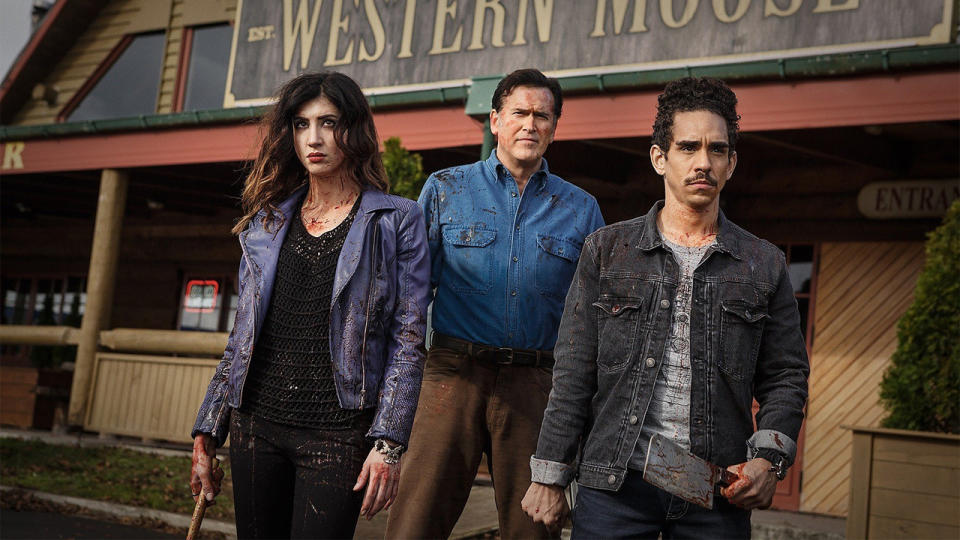
How To Watch Ash Vs. Evil Dead
As you probably could have guessed, Ash vs. Evil Dead is available to stream via Starz – which includes not only their direct subscription service, but also add-ons through Amazon, Hulu, YouTube TV and more. You can also stream the show with a Netflix subscription. Individual episodes and seasons are available for purchase via Prime Video, Google Play, and Apple TV, and physical media collectors can pick up a copy of the Blu-ray box set.
With the highly anticipated Evil Dead Rise set to arrive in theaters everywhere this Friday, this Evil Dead-centric feature series is now coming to an end… but there are still a lot more stories to tell from Horror’s History and Legacy. Stay tuned here on CinemaBlend in the coming weeks as I launch the next installment of this column centering on another iconic scary movie franchise.
